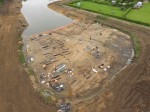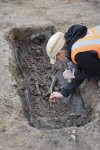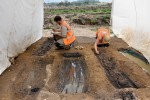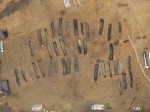 A rare early Christian Anglo-Saxon cemetery has been discovered in an extraordinary state of preservation in Great Ryburgh in Norfolk. Funded by Historic England, Museum of London Archaeology experts excavated the site in advance of the creation of a conservation lake and flood defense system that will leave it fully submerged. The site is already quite soggy, thanks to the high water table of the river valley, which is why the graves in the cemetery have been so incredibly well-preserved. The alkaline water combined with the acidic sand of the area to create a perfect storm for the survival of organic remains.
A rare early Christian Anglo-Saxon cemetery has been discovered in an extraordinary state of preservation in Great Ryburgh in Norfolk. Funded by Historic England, Museum of London Archaeology experts excavated the site in advance of the creation of a conservation lake and flood defense system that will leave it fully submerged. The site is already quite soggy, thanks to the high water table of the river valley, which is why the graves in the cemetery have been so incredibly well-preserved. The alkaline water combined with the acidic sand of the area to create a perfect storm for the survival of organic remains.
 There are six plank-lined graves, the earliest known examples in Britain, and an unprecedented 81 treetrunk coffins dating to the 7th-9th century A.D. Early Anglo-Saxon coffins and wood-lined graves very rarely survive. Usually all archaeologists have to go on are the stains left in the soil by the long-decayed wood. The plank-lined graves were lined with finely hewn timbers and the body laid within. More planks were then placed on top to create a coffin-like enclosure.
There are six plank-lined graves, the earliest known examples in Britain, and an unprecedented 81 treetrunk coffins dating to the 7th-9th century A.D. Early Anglo-Saxon coffins and wood-lined graves very rarely survive. Usually all archaeologists have to go on are the stains left in the soil by the long-decayed wood. The plank-lined graves were lined with finely hewn timbers and the body laid within. More planks were then placed on top to create a coffin-like enclosure.
 While treetrunk coffins have been discovered before, mainly in the 19th century, this is the first time they have been professionally excavated using modern archaeological methods. The coffins were dug out from oak trees cut in half lengthwise. Bodies were placed in the hollowed out center of one half, then the second half of the oak was placed on top to act as a lid. This was a labour-intensive process that would have taken one man an estimated four days to complete. Treetrunk coffins have been found in pre-Christian Anglo-Saxon graves as well, so their presence in this early Christian cemetery may suggest a syncretic combination of old and new religious traditions.
While treetrunk coffins have been discovered before, mainly in the 19th century, this is the first time they have been professionally excavated using modern archaeological methods. The coffins were dug out from oak trees cut in half lengthwise. Bodies were placed in the hollowed out center of one half, then the second half of the oak was placed on top to act as a lid. This was a labour-intensive process that would have taken one man an estimated four days to complete. Treetrunk coffins have been found in pre-Christian Anglo-Saxon graves as well, so their presence in this early Christian cemetery may suggest a syncretic combination of old and new religious traditions.
 There is considerable evidence pointing to this being a Christian burial ground. The graves each have wooden markers and are aligned from east to west, both Christian traditions that are not seen in pagan burials. They also lack grave goods which were an important part of pre-Christian Anglo-Saxon funerary practices. Archaeologists discovered the remains of a timber structure on the site that they think may have been a church or chapel, an extremely rare find from this period.
There is considerable evidence pointing to this being a Christian burial ground. The graves each have wooden markers and are aligned from east to west, both Christian traditions that are not seen in pagan burials. They also lack grave goods which were an important part of pre-Christian Anglo-Saxon funerary practices. Archaeologists discovered the remains of a timber structure on the site that they think may have been a church or chapel, an extremely rare find from this period.
 When the cemetery was in use, the site was on a busy river crossing in the kingdom of East Anglia. There is virtually no documentary evidence from this period of Anglo-Saxon East Anglia, so such a rich, well-preserved site is an invaluable source of information to archaeologists and historians.
When the cemetery was in use, the site was on a busy river crossing in the kingdom of East Anglia. There is virtually no documentary evidence from this period of Anglo-Saxon East Anglia, so such a rich, well-preserved site is an invaluable source of information to archaeologists and historians.
The discovery is shedding light on a previously unknown religious site and the fascinating lives of this early Christian rural community. Continued research and scientific testing, in the form of ancient DNA, stable isotope and dental calculus analysis, will help to develop biographies for the people buried and paint a picture of the people who lived here. Archaeologists hope to be able to say more about where these people came from, whether they were related, and what their diet and health were like, once research is complete.
The timber will be subjected to dendrochronological analysis to give us a more precise date range. Once the remains have been studied and conserved, they will be kept at the Norwich Castle Museum.
As old trees hollow out on their own, one wonders if they were put to this use as coffins in an as-found condition, where an already hollow trunk only needs to be split in two.
let the dead rest in peace.
“Wæter healdeþ ða deádan líchoman ungemolsnode”, Water keeps the dead bodies undecayed (and keeps oxygen away), as they used to put it in Saxony.
For comparison, a treetrunk coffin from the huge 5th to 7th century Frankish/ Alemannic graveyard of Oberflacht in Germany (found in the 19th century – in 1860, two of those coffins ended up in Nuremberg).
During necessary conservation works done almost a century later, experts from Mainz found in those coffins medieval apple and cherry seeds and even a little textile cross, all baked-together in a piece of dirt.
Apparently, in others of the coffins, there were all kinds of grave goods. Here, bees wax candles, dating to the 6th or beginning 7th century.